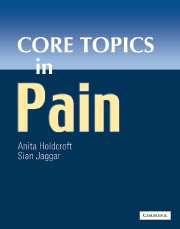Book contents
- Frontmatter
- Contents
- Contributors
- Preface
- Acknowledgements
- Foreword
- General abbreviations
- Basic science abbreviations
- PART 1 BASIC SCIENCE
- PART 2 PAIN ASSESSMENT
- Section 2a Pain measurement
- Section 2b Diagnostic strategies
- PART 3 PAIN IN THE CLINICAL SETTING
- Section 3a Clinical presentations
- 14 Epidemiology of pain
- 15 Pain progression
- 16 Analgesia in the intensive care unit
- 17 The chronic pain patient
- 18 Post-operative pain management in day case surgery
- Section 3b Pain syndromes
- PART 4 THE ROLE OF EVIDENCE IN PAIN MANAGEMENT
- PART 5 TREATMENT OF PAIN
- Section 5a General Principles
- Section 5b Physical treatments
- Section 5c Pharmacology
- Section 5d Psychosocial
- PART 6 SUMMARIES
- Glossary
- Index
14 - Epidemiology of pain
from Section 3a - Clinical presentations
Published online by Cambridge University Press: 10 December 2009
- Frontmatter
- Contents
- Contributors
- Preface
- Acknowledgements
- Foreword
- General abbreviations
- Basic science abbreviations
- PART 1 BASIC SCIENCE
- PART 2 PAIN ASSESSMENT
- Section 2a Pain measurement
- Section 2b Diagnostic strategies
- PART 3 PAIN IN THE CLINICAL SETTING
- Section 3a Clinical presentations
- 14 Epidemiology of pain
- 15 Pain progression
- 16 Analgesia in the intensive care unit
- 17 The chronic pain patient
- 18 Post-operative pain management in day case surgery
- Section 3b Pain syndromes
- PART 4 THE ROLE OF EVIDENCE IN PAIN MANAGEMENT
- PART 5 TREATMENT OF PAIN
- Section 5a General Principles
- Section 5b Physical treatments
- Section 5c Pharmacology
- Section 5d Psychosocial
- PART 6 SUMMARIES
- Glossary
- Index
Summary
Introduction
Epidemiology is the study of the distribution and determinants of diseases and the application of the findings to the control of health problems. By studying the distribution of a disease we can learn about:
How many people are affected.
Who is at risk.
Causes.
Risk factors.
Epidemiology has various applications:
Understanding the natural history of a disease.
Planning and evaluating services.
Disease prevention:
— Primary: stopping the problem from arising.
— Secondary: early detection and treatment.
— Tertiary: minimising impairment and disability.
Epidemiological studies of pain
The first step in the study of a disease is to define the population group and develop a valid set of diagnostic criteria. This has been a major problem in studies both on the general problem of pain as a whole and of specific conditions.
Prevalence is the number of cases of a given disease in a given population at a designated time (e.g. ‘point’, ‘period’ and ‘lifetime’ prevalence).
Incidence is the number of new cases arising during a given period in a specified population.
There have been many studies published on the prevalence of chronic pain. The results of these studies vary widely, because they used different:
Study populations.
Diagnostic criteria.
- Type
- Chapter
- Information
- Core Topics in Pain , pp. 99 - 102Publisher: Cambridge University PressPrint publication year: 2005
- 1
- Cited by



